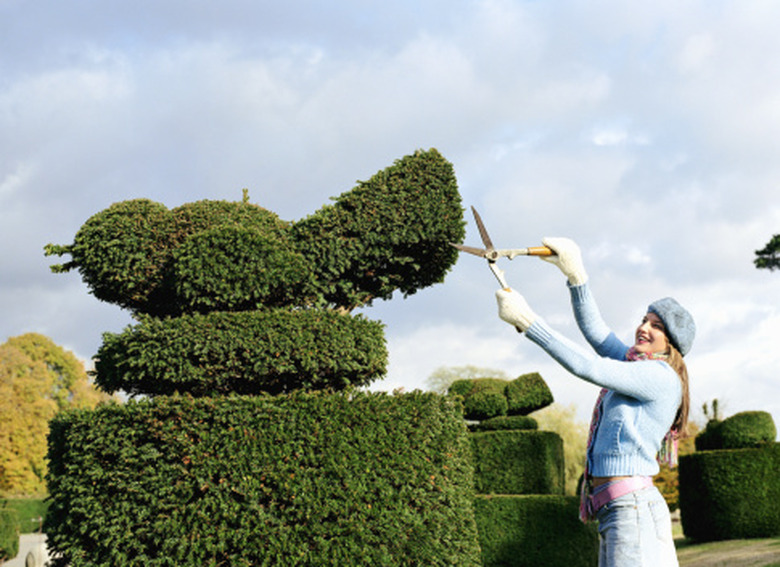How To Sculpt Garden Bushes
Sculpting garden bushes is a horticultural art known as topiary, a term that refers to the process and the final product. Gardeners sculpt bushes to create a more formal look in their gardens, whether by sculpting geometric shapes, archways or animals. Topiary sculpting takes several years to achieve desired results because you must wait for the bush to mature and you can only trim a little at a time. Many topiary sculptors use metal frames to guide the shaping and pruning of bushes. The best bushes to sculpt are evergreens with small leaves and dense growth, such as boxwood or yew.
Using a Frame/ Starting New Bushes
Step 1
Plant one evergreen shrub for each place that the frame will contact the soil. The frame will have specific instructions, but sculpting a four-legged animal, for example, requires one shrub planted for each leg.
- Sculpting garden bushes is a horticultural art known as topiary, a term that refers to the process and the final product.
- Gardeners sculpt bushes to create a more formal look in their gardens, whether by sculpting geometric shapes, archways or animals.
Step 2
Position the frame over the plants and mulch around the plants.
Step 3
Fertilize the plants about once per month and water as needed to maintain moist soil.
Step 4
Tuck branches inside the frame or tie them to the frame as needed to follow the shape of the frame.
Step 5
Prune 1 inch off branches in areas that need more growth to fill in; use pruning shears, lopping shears or bypass shears. Pruning short pieces encourages bushier growth for a fuller plant.
Step 6
Prune the bushes every two to three months during the growing season, using the frame to guide your cuts. Prune no more than 3 inches from each branch at a time to encourage new growth without killing sections of the bush.
- Position the frame over the plants and mulch around the plants.
- Prune no more than 3 inches from each branch at a time to encourage new growth without killing sections of the bush.
Step 7
Trim the bushes back about two months before the end of the growing season to allow the branches time to heal before entering the winter dormancy period.
Step 8
Reduce the frequency of fertilizing once the bushes have grown to maturity and the desired shape is achieved. This will slow the rapid growth to reduce the amount of pruning needed to maintain the shape.
Without a Frame/ Mature Bushes
Step 1
Decide on the shape that you would like to achieve, whether it be a column, pyramid, globe, spiral or intricate animal shape. Simple geometric designs are best for novice sculptors as they develop their bush sculpting skills.
Step 2
Refer to a picture of a similar design as you sculpt your bushes. It may also be helpful to take a photograph of the bush you will sculpt so you can make a plan before you begin pruning.
- Trim the bushes back about two months before the end of the growing season to allow the branches time to heal before entering the winter dormancy period.
- It may also be helpful to take a photograph of the bush you will sculpt so you can make a plan before you begin pruning.
Step 3
Water and fertilize the bush the day before you begin sculpting to ensure the plant has plenty of nutrients to be able to heal after it is pruned.
Step 4
Start sculpting the bush into shape by trimming 3 inches off the plant during a single pruning. Pruning shears work well for small bushes, but larger bushes may be easier to sculpt with bypass shears or lopping shears.
Step 5
Wait two or three months and then prune an additional 3 inches in the shape you desire. Continue doing this every two to three months in the growing season until you achieve desired results.
Step 6
Prune the bush for the last time in the growing season about one or two months before the winter dormancy period begins.
Step 7
Prune new growth from the plant as needed to maintain the shape of the bush once the desired design is achieved.
- Water and fertilize the bush the day before you begin sculpting to ensure the plant has plenty of nutrients to be able to heal after it is pruned.
- Prune new growth from the plant as needed to maintain the shape of the bush once the desired design is achieved.
Tip
Sculpted garden bushes don't require ornate designs — even hedges are a type of topiary because they are sculpted into a formal shape.
Warning
A frame is necessary for sculptures that you will walk through, such as an arch, or for top-heavy designs that can't be supported by the trunk alone.
